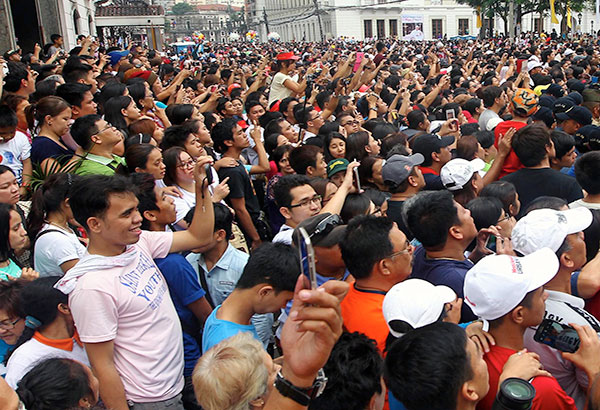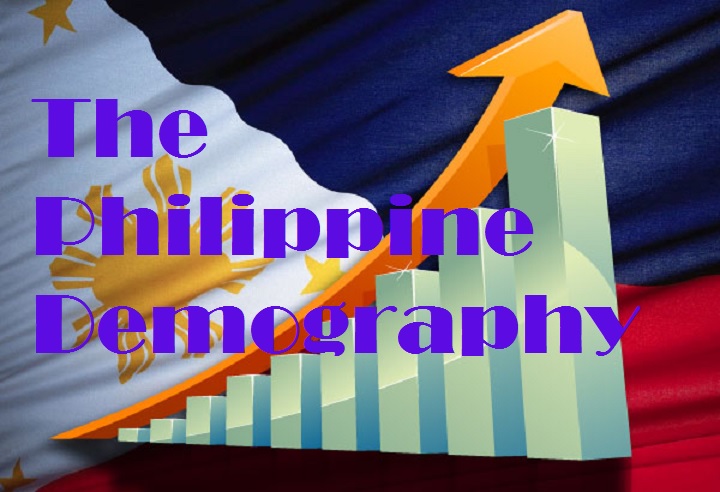What is Philippine Demography? Do you want to know? Just keep on reading and find out.
The Philippine Demography is a collection of statistical data (meaning numbers) of the human population in the Philippines, which involves the population density, education level, health, ethnicity, religious affiliations, economic status and other etc.
The Philippine population
The development in Philippine population is documented mainly to the additional of births over deaths. Like any other evolving country, Philippines have an extraordinary birth rate and a progressively decreasing mortality rate. World-wide immigration, on the other hand, is somewhat a null status. Statistics on population and vigorous evens such as live births, deaths, fetal deaths, and marriages are engaged from population censuses, demographic surveys, and civil registration.
The current population of the Philippines is 102,634,679 as of Sunday, October 2, 2016, based on the latest United Nations estimates.

- The Philippines population is equivalent to 1.37% of the total world population.
- The Philippines ranks number 12 in the list of countries by population.
- The population density in the Philippines is 343 per Km2 (888 people per mi2).
- The total land area is 298,192 Km2 (115,133 sq. miles)
- 44.9 % of the population is urban (45,842,660 people in 2016)
- The median age in the Philippines is 24.4 years
- The Current Statistics of the Philippine Population as of 2016
- 51 500 282 – Current male population (50.1%)
- 51 195 668 – Current female population (49.9%)
- 1 813 577 – Births this year
- 506 590 – Deaths this year
- -109 799 – Net migration this year
- 1 197 188 – Population growth this year
The Philippine Ethnicity
The isles of the Philippines are populated by a total of diverse ethno-linguistic groups, the common of whose own languages are Austronesian in the beginning. Several of these groups adapted to Christianity, mostly the lowland-coastal groups, and accepted many foreign foundations of philosophy. Ethno-linguistic groups include the Ivatans, Ilocanos, Pangasinenses, Kapampangans, Tagalog people, Bicolanos, the Visayans which includes the Masbateños, Hiligaynons/Ilonggos, Cebuanos, Boholanos/Bol-anons, Warays and Surigaonons. And also the group from Mindanao which are the Maranaos, Subanons and Zamboangueños.
In some parts of the western Mindanao and the Sulu Archipelago, there are local groups who exercise the religion of Islam. The Spanish named them the Moros in reference to the Moors (despite no similarity or cultural ties to them separately from their religion). In the Agusan Marsh and the moorlands of Mindanao, there are the innate ethnic groups communally known as the Lumad. Unlike the Moros, these individuals do not practice Islam, and preserve their animistic beliefs and traditions though some of them have adapted to Christianity as well.

The Negritos are a pre-Austronesian folks who travelled from mainland Asia and were one of the first human beings to settle the Philippines, around 90,000 years ago. The earliest known were the individuals of the Callao Man remains. The Negritos population was estimated in 2004 at around 31,000. Their ethnic groups consist of the Ati tribe, and the Aeta group. Their ways of life remain mostly free from Western and Islamic effects. Researchers study them to try to comprehend pre-Hispanic culture.
The Philippine Educational Level
Primary Education
Paaralang Elementarya or elementary education is the primary part of the educational system, and it comprises the main six years of required education from grade 1 to 6, with an elective 7th grade presented by some schools. Major subjects are consisted of Mathematics, Science, English, Filipino and History. Elective subjects are consists of music, arts, physical education, and health. Private school pupils may hand-picked subjects from a wider curriculum including religious training in the doctrine of their choice.
Until 2004, primary students traditionally prepares for the National Elementary Achievement Test (NEAT) managed by the Department of Education (DepEd). However, the scores gained by students in the NEAT were not used as a source for their admittance into Secondary school.

During 2004, the NEAT was transformed to National Achievement Test (NAT) by the Department of Education (DepEd). Pupils from both public and private elementary schools take this assessment to measure a school’s proficiency. As of 2006, only private institutes have entrance tests for Secondary school.
Middle Education
Middle school education is a part of the Primary (or Elementary) Education
Secondary Education

Secondary education known as Paaralang Sekundarya includes 4 grades that have altered a little since the Second World War. The curriculum is prearranged for both private and public schools. Fundamental subjects are as follows:
Year 1 – Filipino 1, Algebra 1, Integrated Science, English 1, Philippine History
Year 2 – Filipino 2, Algebra 2, Biology, English 2, Asian History
Year 3 – Filipino 3, Geometry, Chemistry, World History, Geography
Year 4 – Filipino 4, Calculus, Trigonometry, Physics, Literature, Economics
Minor optional subjects comprise Health, Music, Arts, Physical Education, Home Economics and Technology. Selected schools present further subjects. Over-all secondary institutes numbers exceed 5.5 million.
Vocational Education
Accredited mainly in private institutions, known as the colleges, that offers technical and vocational education. Programs offered vary in period from a few weeks to two-year certificates. On accomplishment, students may take centrally-administered examinations to gain their certificate.
Vocational colleges don’t usually require an entrance examination, only a record of high school education and an enrolment fee.
Tertiary Education
Philippine University are the most institutions of advanced learning are controlled by the commission for higher education.
Colleges typically offer 1 or more specialized courses while colleges must offer at least 8 different undergraduate degree programs in an extensive array of subjects and at minimum of 2 graduate programs.

Civic universities are all non-sectarian and offer a variety of programs, with English as a medium of teaching. Communal universities are government financed, with the largest, the University of the Philippines, getting the substantial share of the yearly budget.
There are also quantities of private tertiary universities, sectarian or non-sectarian as well as for-profit or not-for-profit. Most private schools are Catholic non-profit organizations.
Most institutions offer 4 year degree programs with 2 semesters per year.
In 2010, a course on Business and Administration was established by 26.9% of college graduates. About one-fifth (19.3%) of the total college graduates completed a course in the area of expertise in Teacher Training and Education Sciences while 13.7% were bachelor graduates of Engineering and Engineering Trades programs.

Bachelor Degrees on business and on education have reliably been the most prevalent among college undergraduates in the last two decades. Among college alumni under the age of 40 years, 23.5% had a degree on Business and Administration, 16.8% were alumni of Teacher Training and Education Sciences programs, and 13.6% were degree holders of Health programs. Meanwhile, among those college alumni aged 40 years and above, 32.5% finished a degree on Business and Administration, 23.5% proceeded with a degree on Teacher Training and Education Sciences, and 15.8% were graduates of Engineering and Engineering Trades programs.

The most common academic field for males was Engineering and Engineering Trades, with degree holders of this program comprising 25.9% of the total male college graduates. While the most communal field for females was Business and Administration with 31.3%t of the total female degree holders in this field.
Filipino Religious Affiliations
The Philippines pompously claim to be the only Christian Country in Asia. More than 86% of the populace is Roman Catholic, 6% belong to several nationalized Christian sects, and another 2% belong to well over 100 Protestant values. Adding more to the Christian mainstream, there is a dynamic 4% Muslim minority, focused on the southern islands of Sulu, Palawan, and Mindanao. Distributed in remote mountainous regions, the remaining 2% follow the non-Western, indigenous principles and observes. The Chinese sectional, although statistically irrelevant, has been culturally influential in coloring Filipino religious affiliations with many of the views and performs of Buddhism, Taoism, and Confucianism.

Upon this native religious base two foreign religions were presented — Islam and Christianity — and a procedure of cultural version and mixture began that is still evolving. Spain presented Christianity to the Philippines in 1565 with the coming of Miguel Lopez de Legazpi. Earlier, beginning in 1350, Islam had been scattering northward from Indonesia hooked on the Philippine archipelago. By the time the Spanish reached in the 16th century, Islam was decisively established on Mindanao and Sulu and had settlements on Cebu and Luzon. At the time of the Spanish coming, the Muslim areas had the maximum and most politically incorporated culture on the islands and, given more time, would probably have united the entire archipelago.

While Islam was controlled in the southern islands, Spain occupied and adapted the rest of the islands to Hispanic Christianity. The Spaniards rarely had to resort to military force to win over converts, instead the imposing display of splendour and condition, religious garb, pictures, devotions, and worship fascinated the rural populace. To defend the population from Muslim slave attackers, the people were transferred from isolated discrete villages and conveyed “debajo de las companas” which means under the bells, into Spanish prearranged pueblos. This set of arrangement that is obvious in modern Philippine Christian towns. These pueblos had both public and religious authority; the central power during the Spanish period was in the hands of the parish priest. The church, located on a central plaza, became the focus of town life. Masses, confessions, baptisms, funerals, marriages disrupted the dullness of everyday routines. The church calendar agreed the speed and rhythm of daily life according to fiesta and liturgical seasons.

When the United States seized over the Philippines in the early part of the century, the explanations for inhabiting were to Christianize and democratize. The sentiment was that these objectives could be attained only through mass teaching. Most of the educators who travelled to the Philippines were Protestants, several were even Protestant ministers. There was a sturdy predisposition among some of these educators against Catholics. Since this Protestant group introduced and organized the system of public schooling in the Philippines throughout the American colonial period, it used a solid influence. Successively the balance has lifted to reflect much sturdier influence by the Catholic mainstream.

Throughout the period of armed uprising against Spain, a state-owned church was organized under Gregorio Aglipay, who was made “Spiritual-head of the Nation Under Arms.” Spanish archbishops were detached and imprisoned, and church possessions were turned over to the Aglipayans. In the primary part of the 20th century the numbers of Aglipayans emaciated at 25 to 33% of the population. Currently, they have deteriorated to about 5% and are related with the Protestant Episcopal Church of the United States. Another active nationalized Christian sect is the lglesia ni Kristo, inaugurated around 1914 and established by Felix Manolo Ysagun.
The present encounter to the sovereignty of the Catholic church originates from a variety of small sects — from the fundamentalist Christian clusters such as the group of Jehovah’s Witnesses and Seventh Day Adventists, to the lglesia ni Kristo and Rizalists. The Roman Catholics suffer from a deficiency of people (the priest to people ratio is exceedingly low), putting them at a drawback in gaining and maintaining popular support. The Catholic Church is looking for to meet this trial by founding an increasingly native clergy and by engaging in programs geared to social action and human rights among the pastoral and municipal poor. In many circumstances, this motion has led to friction between the church and the Marcos government, causing in apprehensions of priests, nuns, and nonprofessional people on charges of subversion. In the “war for souls” this may be a required expense. Currently, the biggest increasing spiritual sector falls within the province of these smaller, grass roots sects; but only the time will express where the fractions will finally rest.
References:
The Philippines Demography Data, https://www.quandl.com/collections/philippines/philippines-demography-data,
Philippines Demographics Profile 2016, http://www.indexmundi.com/philippines/demographics_profile.html,
National Quickstat for 2016, https://psa.gov.ph/statistics/quickstat/national-quickstat/all/*

Leave a Reply